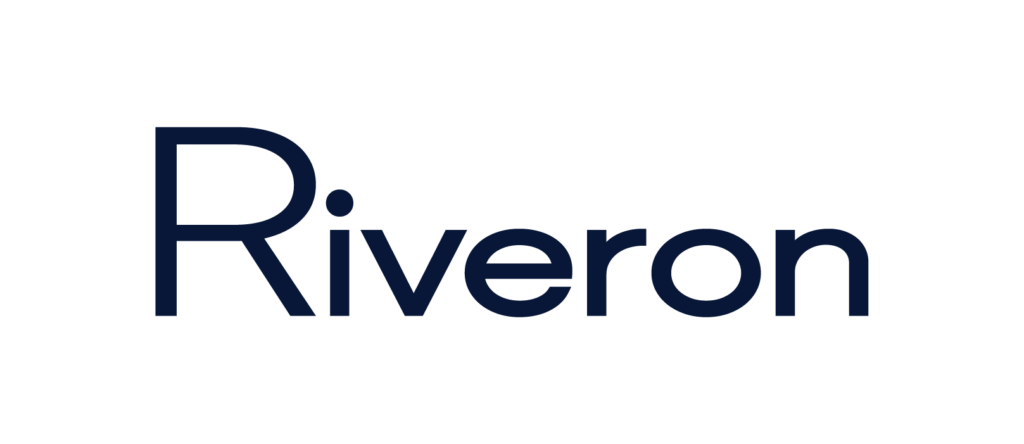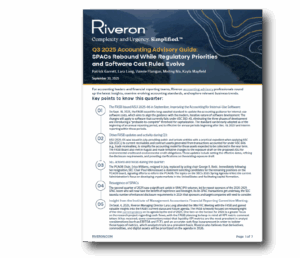Q3 2025 Accounting Advisory Guide: SPACs Rebound While Regulatory Priorities and Software Cost Rules Evolve
For accounting leaders and financial reporting teams, Riveron accounting advisory professionals round up the latest insights, examine evolving accounting standards, and explore relevant business trends.
Key points to know this quarter:
- The FASB issued ASU 2025-06 in September, improving the accounting for internal-use software: On Sept. 18, 2025, the FASB issued the long-awaited standard to update the accounting guidance for internal-use software costs, which aims to align the guidance with the modern, iterative nature of software development. The changes will apply to software that currently falls under ASC 350-40, eliminating the three phases of development and introducing a “probable-to-complete” threshold for capitalization. The standard can be early adopted as of the beginning of an annual reporting period, and is effective for annual periods beginning after Dec. 15, 2027 and interim reporting within those periods.
- Other FASB updates and activity during Q3: ASU 2025-05 was issued in July, providing public and private entities with a practical expedient when applying ASC 326 (CECL) to current receivables and contract assets generated from transactions accounted for under ASC 606 (e.g., trade receivables), to simplify the accounting model for those assets expected to be collected in the near term. The FASB Board also met in August and made tentative changes to the exposure draft on the proposed ASU for environmental credits and environmental credit obligations. These updates include setting the effective dates, refining the disclosure requirements, and providing clarifications on the existing exposure draft.
- SEC actions and focus during the quarter: The PCAOB Chair, Erica Williams, resigned in July, replaced by acting chair George R. Botic. Immediately following her resignation, SEC Chair Paul Atkins issued a statement soliciting candidates for the remaining positions on the PCAOB board, signaling efforts to reform the PCAOB. The topics on the SEC’s 2025 Spring Agenda reflect the current Administration’s focus on developing crypto markets in the United States and facilitating capital formation.
- Resurgence of SPACs: The second quarter of 2025 saw a significant uptick in SPAC IPO volumes, led by repeat sponsors of the 2020-2021 SPAC boom who will now have the benefit of experience and hindsight. As de-SPAC transactions get underway, the SEC issued a number of enhanced disclosure requirements in 2024 that sponsors and target companies will need to consider.
- Insight from the Institute of Management Accountants Financial Reporting Committee meeting: On Sept. 4, 2025, Riveron Managing Director Lara Long attended the IMA FRC meeting with the FASB and gained valuable insights into the FASB’s current status and future agenda. The FASB is heavily focused on releasing eight of the nine current projects on its agenda by the end of 2025. One item on the horizon for 2026 is a greater focus on the research project regarding cash flows, with the FASB planning to keep in mind all KPI metric comment letters it has received; some commenters noted that liquidity KPI metrics are the most prevalent in analyst considerations (such as EBITDA and FCF), and an accurate cash flow is paramount in order to bolster those types of metrics, which analysts track on a prevalent basis. Riveron also believes that derivatives, commodities, and digital assets will be prioritized on the agenda in 2026.
1. Accounting Standards Updates
ASU 2025-05 – Amends guidance on the measurement of credit losses for accounts receivable and contract assets
The FASB issued ASU 2025-05 in July 2025, amending ASC Topic 326 to simplify the process for applying the current expected credit loss (CECL) model to short-term assets, such as current accounts receivable and current contract assets recorded under ASC 606. Stakeholders, particularly private companies, have expressed that the process of building and documenting forward-looking macroeconomic forecasts to use in the existing model can be costly and often results in an immaterial allowance impact for these types of assets. The new standard is expected to reduce unnecessary complexity while still providing useful information to the users of financial statements. In practice, this update will allow preparers to avoid writing time-consuming memos regarding future economic conditions, which are often difficult to prepare and a contentious item in the audit process due to their subjectivity.
ASC 2025-05 provides a practical expedient for all entities, allowing companies to assume that the current conditions as of the balance sheet date will not change over the remaining life of the current asset, eliminating the need to incorporate macroeconomic forecasts for short-term balances. Additionally, the new standard provides an accounting policy election to entities, other than public business entities that elected the practical expedient, which permits the consideration of subsequent collection activity up to the date the financial statements are issued in developing the allowance. This effectively allows receivables collected after the balance sheet date to carry no associated allowance, aligning the estimate more closely with actual outcomes.
ASU 2025-05 is effective for annual periods beginning after Dec.15, 2025, including interim periods, with early adoption permitted. The amendments must be applied prospectively. It is anticipated that these changes will reduce compliance costs, simplify estimation, and provide flexibility—particularly for private companies and not-for-profit entities—while retaining transparency through targeted disclosure requirements.
New ASU 2025-07 clarifies accounting for derivatives
Announced on Sept. 29, 2025, the FASB issued ASU 2025-07 (Derivatives Scope Refinements), which provides targeted relief on derivative accounting by creating a new scope exception for contracts with underlyings based on a party’s operations, while also clarifying the application of revenue recognition guidance (Topic 606) for share-based consideration received from customers. This crucial update is designed to reduce reporting complexity and cost while improving the relevance and comparability of financial statement information for these types of complex transactions.
Tentative Board decisions on the proposed ASU for Environmental Credits and Environmental Credit Obligations (Topic 818)
The FASB issued an exposure draft for Topic 818 on Dec. 17, 2024, to improve the financial accounting for and disclosure of environmental credits and environmental credit obligations (ECOs). Companies increasingly buy, generate, or hold environmental credits (such as renewable energy certificates, carbon offsets, and cap-and-trade allowances). Before Topic 818, US GAAP had no comprehensive guidance, which led to inconsistent accounting practices. The proposed update provides recognition, measurement, presentation, and disclosure requirements for all entities that purchase or hold environmental credits or have a regulatory compliance obligation that may be settled with environmental credits. Topic 818 gives preparers a structured, intent-based framework for recognizing credits and obligations, improves comparability, and supports transparency around sustainability-related accounting.
During the Aug. 13, 2025 FASB Board Meeting, tentative board decisions were made related to this update. Here is a summary of key areas and what has been affirmed or changed compared to the previous exposure draft:
What hasn’t changed: Affirmed concepts
- Recognition model: Intent-based model remains. Credits are only recognized if they will probably be transferred or used to settle an ECO. Credits acquired for purely voluntary retirement are expensed when incurred.
- Two credit buckets for asset recognition:
- Compliance credits: measured at cost (no impairment).
- Noncompliance credits: measured at cost with impairment; a fair value policy election is permitted for eligible classes (e.g., acquired or certain nonreciprocal transfers). Costing choices (FIFO/avg. cost/specific ID) and a portfolio approach are retained.
- ECO (liability) model remains: ECO liabilities are measured as if the reporting date is the end of the compliance period, split into funded (covered by on-hand compliance credits) and unfunded (generally at the fair value of credits needed to settle). Changes run through earnings. Offsetting is prohibited; present assets and liabilities gross with current/noncurrent split based on expected settlement within 12 months.
- Scope/interaction with ASC 815 preserved: Topic 818 governs environmental credits/ECOs, and credits themselves are outside of derivative accounting, though forward/option contracts on credits can still be derivatives under ASC 815 (the Board was specifically asked to affirm these points).
- Business combinations: An acquirer recognizes environmental credits as assets regardless of intent at the acquisition date; thereafter, they are accounted for under Topic 818.
What’s changed: New or clarified guidance coming out of the August 13 tentative decisions
- Effective dates set: For public entities, this update will be effective for fiscal years beginning after Dec. 15, 2027 (i.e., 2028), including interim periods. For all other entities, it will be effective for fiscal years beginning after Dec. 15, 2028 (i.e., 2029). Early adoption is permitted.
- Disclosure package scaled back from the proposal: The Board pared back some of the more expansive quantitative holdings disclosures (e.g., not requiring disclosure of total credit holdings), while retaining disclosures about use, measurement methods, changes, and income-statement impacts.
- Recognition nuances clarified: Tentative decisions clarify that “probable transfer” can include an exchange or a nonreciprocal transfer and confirm how to treat nonrefundable deposits for voluntary credits.
- Measurement refinements: When measuring the funded portion of an ECO, only compliance credits will count toward funding. Entities will not be required to consider noncompliance or voluntary credits.
- Fair value election boundaries were reiterated and extended: The tentative decisions keep the fair value policy election for eligible noncompliance credits and indicate credits acquired in a business combination may be eligible for that election (if otherwise meeting eligibility). Once the fair value option is elected, it will be applied until derecognition.
Overall, the intent-based model remains intact; recognition is only required when it is probable that the credits will be transferred or used to settle an ECO. The August 2025 decisions confirmed most of the December 2024 exposure draft while adding effective dates, narrowing disclosure requirements, and adding clarifications to the existing exposure draft.
Accounting and finance teams that regularly encounter environmental credit matters should begin inventorying credits by type and tracking probable uses to prepare for modified recognition and disclosure requirements, with an implementation horizon of approximately three years for public entities and approximately four years for private entities, with early adoption possible. M&A teams should plan for future recognition of acquired credits at fair value.
Upcoming activity of the FASB
After the issuance of ASU 2025-06 on accounting for internal-use software costs in September, there are eight proposed ASUs in the final stages of being drafted and voted on by the FASB Board, with a majority expected before the end of 2025, covering the following topics:
- Topic 818: Environmental Credit Programs
- Topic 326: Credit Losses on Purchased Financial Assets
- Topic 815: Derivatives Scope Refinements (announced on Sept. 29, 2025, the FASB issued ASU 2025-07)
- Topic 270: Interim Reporting
- Topic 832: Government Grants
- Codification Improvements
- Measurement of Paid-in-Kind Dividends on Equity-Classified Preferred Stock
- Topics 470 and 405: Debt Exchanges (expected in Q1 2026)
2. Regulatory Updates
Leadership change at the PCAOB
Erica Williams resigned as chair and board member of the PCAOB effective July 22, 2025. She was originally sworn in as PCAOB chair in January 2022 and was reappointed in June 2024. Under her leadership, the PCAOB began to inspect China-based audit firms for the first time in history, issued modernized auditing standards. On Williams’s watch, a rigid approach to enforcement was utilized, which resulted in more robust inspections.
The SEC announced that George R. Botic has been designated to serve as Acting Chair of the PCAOB in the interim period. Botic became a board member in October 2023 and served in various roles at the PCAOB prior to joining the board, including as a Director of the PCAOB’s Division of Registration and Inspections, where he oversaw broker-dealer audits and the registration and inspection of both domestic accounting firms and foreign accounting firms that audit public companies with securities traded in the United States.
On July 23, 2025, Chair Atkins issued a statement soliciting candidates for all five of the PCAOB board positions, including the Chair, signaling broader efforts to reform the PCAOB by potentially replacing the existing board.
SEC’s Spring 2025 agenda
The Office of Information and Regulatory Affairs published the semi-annual Unified Agenda of Regulatory and Deregulatory Actions on Sept. 4, 2025, which includes the SEC’s Spring 2025 Agenda. The SEC’s 2025 regulatory agenda signals a strategic realignment of regulatory priorities under Chair Atkins and a movement toward less enforcement-heavy rulemaking, greater clarity for crypto markets, and more targeted regulations to support capital formation.
The agenda includes three rules in the pre-rules stage, with 18 in the proposed rule stage, and two in the final rule stage. Five of the proposed rules relate to crypto assets and crypto-related regulatory reforms, reflecting the current Administration’s targeted focus on developing crypto markets within the United States. Four of the proposed rules are being introduced to facilitate capital formation, and are proposing to expand accommodations available for Emerging Growth Companies; simplify categorization of registrants and reduce compliance burdens; rationalize disclosure practices to facilitate material disclosure by companies and shareholders’ access to that information; modernize the shelf registration process to reduce compliance burdens and simplify pathways for raising capital for, and investor access to, private businesses.
The Spring 2025 Agenda excludes several notable rule-making initiatives from the previous agenda, including those on human capital/corporate board diversity disclosures, ESG disclosures, and cybersecurity risk management.
Resurgence in SPAC and de-SPAC activity
After a multi-year lull, SPAC IPOs accelerated in 2025, driven largely by repeat sponsors and larger, more disciplined teams, with 80% of the SPAC IPOs through the end of Q2 being led by repeat sponsors.
SPAC IPO volumes picked up meaningfully in the second quarter, with 44 SPAC IPOs priced in Q2 2025 (as compared to 19 in Q1 2025 and just 5 in Q2 2024). Deal focus has tilted toward less capital-intensive, tech-enabled themes, notably AI, crypto/digital assets, energy/data-center infrastructure. The market is also seeing Sponsors and investors put greater emphasis on profitability and disciplined valuation as compared to the 2020–2021 SPAC boom.
Although SPAC IPOs are on the rise, de-SPAC deals remain light in the first half of 2025, with only 13 deals closed in Q2. As the new SPAC IPO surge began in June 2024, many are now hitting the 12-month mark, a point when deal announcements typically materialize. With experienced teams expected to lead the next wave of de-SPAC transactions, there may be a surge in announcements in the back half of the year.
For SPACs and non-public companies that may be considering entering the public markets via a de-SPAC transaction, below are some of the key impacts of the enhanced SEC disclosure rules that went into effect in 2024 that will impact these transactions:
Enhanced disclosures around the sponsor and conflicts of interest:
- The nature and amounts of all compensation earned by the sponsor.
- Any actual (or potential) material conflicts of interest between the SPAC’s unaffiliated shareholders and the SPAC’s sponsor, affiliates, officers and directors or the target company’s officers and directors.
- Additional disclosures around the potential for dilution, including shareholder redemptions, SPAC sponsor compensation, underwriting fees, warrants, convertible securities, and private investment in public equity (“PIPE”) financings.
- Disclosure of a fairness opinion on the de-SPAC transaction is required, if required by the jurisdiction where the SPAC is organized. The SPAC will also be required to disclose certain information about any outside report received by SPAC board of directors that materially relates to the fairness of the de-SPAC transaction.
Targets will be deemed co-registrants:
- Under the new requirements, target companies are required to be co-registrants when a SPAC or another shell company files a registration statement for a de-SPAC transaction. This requirement will hold the private company and its signing persons subject to strict liability under Section 11 of the Securities Act for material misstatements or omissions in the disclosure included or incorporated into the registration statement.
Use of projections:
- Forward-looking safe harbor provisions for forward-looking disclosures, including projections, in de-SPAC registration statements are now unavailable.
- Projected financial information must be clearly distinguished between projections that are based on historical financial results or operational history and those that are not.
- When projections include a non-GAAP financial measure, an issuer now must include an explanation for why the most closely related GAAP measure was not used, in addition to a clear description of the non-GAAP measure and the directly comparable GAAP measure.
Financial statement requirements for the target
- The financial statements of the target deemed to be the predecessor to the SPAC registrant must be audited by a public accounting firm registered with the PCAOB.
- The rules clarify the number of years of financial statements required when the SPAC and private operating company qualify as EGCs, staleness rules applicable to the financial statements, and the requirements to provide financial statements of acquired businesses by the predecessor in the de-SPAC transaction.
Non-financial disclosures of the private operating company
- The timing of nonfinancial disclosures of the private operating company is provided earlier in the lifecycle, which more closely aligns with the timing required in a traditional IPO registration statement.
3. Other Insights and Webinar Replays
In case you missed it, explore our previous insights and webinar replays:
- Previous accounting advisory insights are summarized in our Q1 2025 and Q2 2025 guides.
- Download a self-assessment guide that helps finance and accounting teams reimagine their operations while tackling the day-to-day.
- Explore a checklist and considerations for improving the collaboration between investor relations and FP&A professionals.
- Riveron experts regularly host webinars for accounting and financial reporting professionals, and many sessions offer CPE credit to live participants. Sign up for our newsletter to be notified about future Riveron webinars, including an upcoming 2026 outlook for accounting professionals.
This update provides general information and insights – consult with your advisors for specific guidance.




